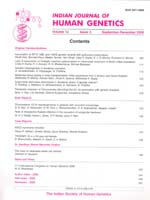
|
Indian Journal of Human Genetics
Medknow Publications on behalf of Indian Society of Human Genetics
ISSN: 0971-6866
EISSN: 0971-6866
Vol. 12, No. 2, 2006, pp. 45-52
|
 Bioline Code: hg06009
Bioline Code: hg06009
Full paper language: English
Document type: Research Article
Document available free of charge
|
|
|
Indian Journal of Human Genetics, Vol. 12, No. 2, 2006, pp. 45-52
| en |
Clinical relevance of alternative splicing
Ravindra T, Lakshmi NK, Chaitanya K, Surender V, Ahuja YR
Abstract
The unique phenomenon of alternative splicing is gathering concern due to its promising
therapeutic potential. The human genome sequencing project suggests approximately 20,000-25,000 genes.
Among these, about 35-60% of genes generate multiple mRNAs by alternative splicing mechanism and
contribute to the diversity of the proteomic world. This 'gene shortfall' has ignited
considerable interest in alternative RNA splicing. This process leads to expression of a single gene
responsible for the transcription of different mRNA isoforms that might have multiple biological functions. The disruption of splicing pattern can produce aberrant splice variants, which are implicated in more than 50% of genetic disorders including cancer. Altered splice sites in neoplastic cell contribute to the development, progression and/or maintenance of tumorous growth. The repertoire of tumor-specific variant represents a potential marker in pharmacogenomic diagnostic relevance. Alternative splice isoforms have been analyzed serendipitously by qualitative gene profiling with in silico gene prediction software. Computational approach in identifying exonic splicing enhancers in genomic DNA and focus on microarray technology will elucidate differential expression of alternative splice variants. The antisense oligonucleotides modulate alternative splicing and engender the production of therapeutic gene products. Oligonucleotides have the potential to silence the mutations caused by aberrant splicing. The efficacy of the antisense oligonucleotides lies in the chemical configuration,
affinity and delivery strategies. Hence the therapeutic potential of antisense oligonucleotides as
modulators of aberrant alternative splicing would be a major challenge to the upcoming proteomic era.
Keywords
Aberrant splice variant, alternative splicing, antisense oligonucleotides, expressed sequence tag, microarrays
|
| |
© Copyright 2006 Indian Journal of Human Genetics.
Alternative site location: http://www.ijhg.com/
|
|
